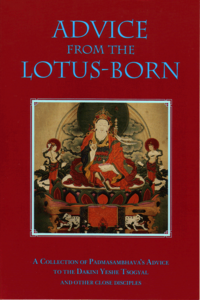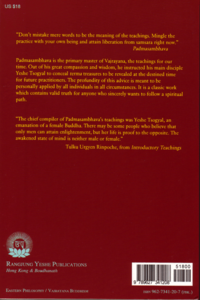Advice from the Lotus-Born
 |
 |
Title
Advice from the Lotus-Born
A collection of Padmasambhava's advice to the dakini Yeshe Tsogyal and other close disciples from the terma treasure revelations of
- Nyang Ral Nyima Özer,
- Guru Chöwang,
- Pema Ledrel Tsal,
- Sangye Lingpa,
- Rigdzin Gödem, &
- Chokgyur Lingpa
Introductory teaching by H. E. Tulku Urgyen Rinpoche
Translated from the Tibetan by Erik Pema Kunsang
Edited by Marcia Binder Schmidt
Publication Data
Padmasambhava, Yeshe Tsogyal, Nyang Ral Nyima Özer, Guru Chöwang, Pema Ledrel Tsal, Sangye Lingpa, Rigdzin Gödem, and Chokgyur Lingpa.
Foreword by Tulku Urgyen Rinpoche (b. 1920). Translated from the Tibetan by Erik Pema Kunsang (Erik Hein Schmidt). Edited by Marcia Binder Schmidt and Kerry Moran.
First ed.
Title: Advice from the Lotus-Born, Vol. I.
ISBN 962-7341-20-7 (pbk.)
1. Extracts from jo mo zhus lan, mnga' bdag nyang gi dmar khrid, dgongs pa zang thal, bla ma dgongs 'dus, mchog gling gter gsar & mkha' 'gro snying thig. 2. Mahayana and Vajrayana — tradition of pith instructions. 3. Buddhism — Tibet. I. Title.
Copyright © 1994 Erik Hein Schmidt
First edition 1994
Cover Picture courtesy of Orgyen Tobgyal Rinpoche
Cover photo: Graham Sunstein
Flat 5a, Greenview Garden,
125 Robinson Road, Hong Kong
Address letters to:
Rangjung Yeshe Publications
p.o. box 1200,
Kathmandu, Nepal
http://www.rangjung.com
editor@rangjung.com
Contents
Foreword 9
Introductory Teaching 13
The Jewel Spike Testament 25
Advice to Trisong Deutsen 34
No Conflict Between the Lesser and Greater Vehicles 41
The Golden Rosary of Nectar 44
Songs to the 25 Disciples 61
The Treasury of Precious Jewels to Dispel Hindrances 68
Advice on How to Practice the Dharma Correctly 99
Pointing the Staff at the Old Man 101
Oral Advice on Practice 104
The Wish-fulfilling Gem of Dedication 117
A Spur Towards Spiritual Practice 127
The Aspiration of the Vajradhatu Mandala 148
Notes 151
Sources 154
Glossary 156
Foreword
The teachings included in Advice from the Lotus-Born were spoken directly by Padmasambhava to his close disciples in Tibet. Primarily they were given in response to questions from Lady Tsogyal, the princess of Kharchen, who wrote them down and concealed them as a precious terma treasure to be revealed many centuries later. Almost every chapter mentions that these instructions were given for the benefit of practitioners of future generations, and often they include the words: “May this meet with all worthy and destined people in the future!”
Advice from the Lotus-Born is a companion volume to Dakini Teachings (Shambhala Publications, 1989), and part of an ongoing effort to present the teachings of Padmasambhava for application by modern-day practitioners. Padmasambhava is the great master who established Buddhism in Tibet during the latter part of the eighth century. The Lotus-Born (Shambhala Publications, 1993) contains the details of his life.
Tulku Urgyen Rinpoche expressed the conviction that an English translation of these precious teachings would bring great benefit. He asked me to seek out and select the most profound instructions involving topics different from those presented in Dakini Teachings.
This volume containing the oral advice of Vajrayana's most outstanding master was collected from various terma teachings. While these revelations span many centuries and were revealed by different people at different places, their language and grammatical style are almost identical.
The material presented here represents only a fraction of the immense body of terma treasures revealed over the last millennium. This book was compiled from the following sources: Rigdzin Gödem's Gongpa Sangtal, Nyang Ral's Martri, Sangye Lingpa's Lama Gongdü, Tongwa Dönden (a compilation), Pema Ledrel Tsal's Khandro Nyingtig, and the Chokling Tersar of Chokgyur Lingpa.
The first chapter, entitled the Jewel Spike Testament, and the sixth and longest chapter, the Treasury of Precious Jewels, are taken from the famous Gongpa Sangtal, a cycle of terma teachings revealed by Rigdzin Gödem (1337-1408), the master of the Jangter or 'northern terma tradition' of the Nyingma school. Rigdzin Gödem literally means 'the vidyadhara with the vulture feather'; he received this name because three vulture feathers grew from his head when he was twelve years old, and five more when he was twenty-four. A reincarnation of Dorje Dudjom of Nanam, one of the nine close Tibetan disciples of Padmasambhava, he is also counted among the five king-like tertöns.
Gongpa Sangtal is an abbreviation of 'Showing Directly the Realization of Samantabhadra,' the primordial buddha. This collection of teachings also contains the renowned 'Aspiration of Samantabhadra.' Gongpa Sangtal consists of five sections; these chapters belong to the one called Kadag Rangjung Rangshar, 'self-existing and self-manifest primordial purity.'
The second major source is Nyang Ral's Martri, the 'Direct Instructions' of Padmasambhava revealed by the great master Nyang Ral Nyima Özer (1124-1192). In Dakini Teachings I briefly described Nyang Ral's life. This set of teachings was included by Jamgön Kongtrül (1813-1899) in Rinchen Terdzö, a renowned collection of terma teachings known as the Precious Treasury of Termas.
The third source is Lama Gongdü, revealed by Sangye Lingpa (1340-1396). The name means the 'embodied realization of the master' (Padmasambhava). Sangye Lingpa was a reincarnation of the second son of King Trisong Deutsen (790-844), and is counted among the Eight Lingpas or major tertöns. His principal revelation was the massive Lama Gongdü cycle of termas in 18 volumes of approximately 700 pages each, and the Kathang Sertreng, the extensive biography of Padmasambhava known as the Golden Chronicles.
Tongwa Dönden means 'meaningful to behold,' and is a biography of Padmasambhava compiled from three major sources: the Kathang chronicles revealed by Orgyen Lingpa (1329-1360/67), Nyang Ral (1124-1192), and Guru Chöwang (1212-1270). Consisting of 274 large block-print folios, this manuscript was found in the library of Shechen Tennyi Dargye Ling in Boudhanath. The colophon mentions that it includes material from: 1) the Extensive Biography of the Great Master of Uddiyana, revealed by Orgyen Lingpa from the supreme place of the Crystal Cave of Yarlung; 2) the Testament of Padma, revealed by the great tertön Nyang Ral; 3) the Biography of 45 Deeds, composed by Princess Mandarava and condensed into the Biography of 11 Deeds by Guru Chöwang, the tertön of Lhodrak; and 4) separate instructions, various replies to questions, and prophecies from the Lama Gongdü cycle of Sangye Lingpa.
As the fourth source, I used a chapter from Pema Ledrel Tsal's Khandro Nyingtig, the 'Heart Essence of the Dakinis.' Padmasambhava concealed his teachings on the Innermost Unexcelled Cycle of the Great Perfection to be revealed in the future as Khandro Nyingtig. The tertön of this important cycle was Pema Ledrel Tsal (1291-1315/9), a reincarnation of Princess Pema Sal, the daughter of King Trisong Deutsen. His immediate rebirth was as the illustrious master Longchen Rabjam (1308-1363) followed by Pema Lingpa (1445-1521). In recent years this master incarnated as Khenpo Ngakchung, alias Ngawang Palsang (1879-1941), who also used the name Pema Ledrel Tsal.
Lastly, the Aspiration of the Vajradhatu Mandala is the single most important chant of good wishes in the Chokling Tersar. It is recited from memory at the end of almost any spiritual gathering in the Kagyü and Nyingma traditions. The Chokling Tersar, the 'New Terma Treasures of Chokgyur Lingpa' (1829-1870), were discovered by the great tertön and his two close associates Jamyang Khyentse Wangpo (1820-1892) and Jamgön Kongtrül the First (1813-1899).
Thanks to His Eminence Tulku Urgyen Rinpoche, who upholds the heart of Padmasambhava's teachings, for kindly explaining any question I had and for his profound instructions illuminating the depth of the view presented in this book; and to Chökyi Nyima Rinpoche for extensively teaching the Dharma over the years, including two seminars covering questions and answers between Padmasambhava and Yeshe Tsogyal.
Lastly, I rejoice in the fact that these translations were completed at the Asura Cave Temple on the tenth day of the lunar month, a day on which Padmasambhava promised to come from his pure land, the Glorious Copper-colored Mountain, to bless whoever calls upon him. May these precious teachings deeply inspire whoever reads them!
Erik Pema Kunsang
Nagi Gompa, 1994
Sources
Chapter 1 — The Jewel Spike Testament: From the Kadag Rangjung Rangshar section of the Gongpa Sangtal, Volume IV (HRIH), pgs. 55-74. Tibetan title: zhal chems rin chen gzer bu%
Chapter 2 — Advice to Trisong Deutsen: Rinchen Terdzö edition, pgs. 180-191.
Chapter 3 — No Conflict between the Lesser and Greater Vehicles: From Rinchen Terdzö, Volume I; Section 4 of the Martri (pgs. 200-203).
Chapter 4 — The Golden Rosary of Nectar: Tibetan title: zhus len bdud rtsi gser phreng bzhugs lags so%
Chapter 5 — Songs to the 25 Disciples: Songs of pith instruction to each of the 25 close disciples, 48th chapter in Tongwa Dönden, page 139b. The same songs are found in the Prophecies from Lama Gongdü, pgs. 216-222. Prophesies from Lama Gongdü. Tibetan title: bla ma dgongs pa 'dus pa las, ma 'ong lung bstan gsang ba'i dkar chag bkod pa'i lung bstan bka' rgya%
Chapter 6 — The Treasury of Precious Jewels to Dispel Hindrances, Replies to Questions from Yeshe Tsogyal: From the Kadag Rangjung Rangshar section, Volume IV (HRIH) of the Gongpa Sangtal, chapter 13/PO ,pgs. 261-320.. Tibetan title: gegs sel nor bu rin po che'i mdzod; mtsho rgyal zhus lan%
Chapter 7 — Advice on How to Practice the Dharma: Rinchen Terdzö, Vol. “I”, pgs. 230-254. Corresponds roughly to Lama Gongdü Vol. CA, pgs. 842-867.
Chapter 8 — Pointing the Staff at the Old Man: Rinchen Terdzö pgs. 463-467.
Chapter 9 — Oral Advice on Practice: From Lama Gongdü, Vol. CA, pg. 842. Corre¬sponds to Rinchen Terdzö, Vol. I, pgs. 230-254. Tibetan title: spyod pa'i zhal gyis gdams pa%
Chapter 10 — The Wishfulfilling Gem of Dedication: From Lama Gongdü Vol. GA, pgs. 55-72. Tibetan title: bla ma dgongs pa 'dus pa las: bsngo ba nor bu bsam 'phel zhes bya ba bzhugs so%
Chapter 11 — A Spur Towards Spiritual Practice: A spur towards spiritual practice through the expedient meaning. A collection from Tongwa Dönden.
Chapter 12 — The Aspiration of the Vajradhatu Mandala: Found in both the Rinchen Terdzö and Chokling Tersar collections of terma treasures.
Glossary — The glossary draws on the following sources: oral teachings from Chökyi Nyima Rinpoche, Tulku Urgyen Rinpoche and Tulku Pema Wangyal; glossaries from our previous publications; notes compiled over the years by Matthieu Ricard; notes from Peter Roberts. For details of the twenty-five disciples of Padmasambhava I am also indebted to Tulku Thondup’s Tantric Tradition of the Nyingmapa (Buddhayana 1984), and H.H. Dudjom Rinpoche’s The Nyingma School: Its History and Fundamentals (Wisdom Publications), translated by Gyurme Dorje and Matthew Kapstein.
Glossary
Glossary to Advice from the Lotus-Born (also available at [1])